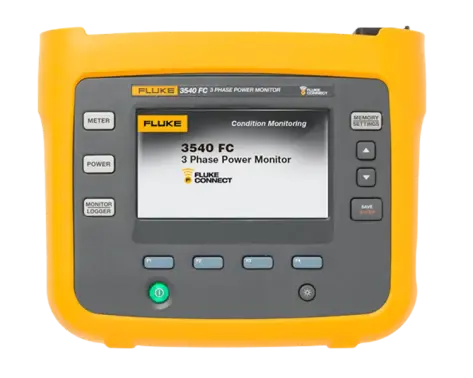Three Phase Power Monitoring
A three-phase power monitor detects changes in electrical variables. With power monitoring on your assets, you can help reduce wear and damage, while also identifying what’s causing it. The Fluke 3540 FC three-phase power monitor can be used remotely or through a stationary connection.
Three-Phase Power Monitoring FAQ
Power quality refers to two things: the quality of your power supply, and the ability of an asset to use that power. Ensuring power quality is key to both saving costs and maximizing profits. For example, unplanned downtime and maintenance due to power issues can cost a significant amount of time and money. In addition, machinery that uses power inefficiently can drive up your energy consumption and costs.
By optimizing your power, you reduce the risk of equipment overheating or failing unexpectedly, and you can reduce the maintenance costs associated with frequently responding to such issues. Furthermore, high quality power helps you maintain high levels of productivity and efficiency throughout your facility.
How to Ensure Power Quality?
To ensure power quality , you need to have a reliable power source and your electrical equipment must be able to consume that power efficiently.
Some of the most common power quality issues include voltage instability, imbalance, and electrical harmonics. Failure to fix these issues promptly can drive up your energy usage and your power costs. They can also impact assets’ performance, leading to increased maintenance costs and even machine failure.
Power monitoring tools allow you to measure your assets’ power quality. Used correctly, power monitoring tools will alert you to any power quality issues so that you can correct them well before they lead to breakdown or failure.
How Does Power Monitoring Work?
Power monitoring provides you with precise data on power usage throughout your plant. A power monitoring program uses tools like sensors and meters to measure exactly how much power each of your key assets is using. You can also monitor your power distribution units and your power supply.
Depending on the type of equipment you are monitoring, you may need different kinds of sensors. You will also need to decide which assets require power monitoring. It is also possible to measure power usage by rack, room, or entire facility.
Your power monitors and meters can send data to an analytics program so that you can understand at a glance how power is being used at the level of the facility, power strip, and device. This gives you insights into your peak power usage times. By tracking power usage over time, you’ll also be able to see when usage deviates from normal baselines, and you can schedule maintenance to address these issues before they become bigger problems.
Why is Power Monitoring Important?
Power Monitoring helps you to see exactly how your plant is using electricity. Over time, power monitoring will also allow you to make decisions that will maximize energy efficiency, lower your electricity bill, and maintain the health of your electrical machinery. Power monitoring is a good way to lower maintenance costs and reduce costly unplanned downtime.
Power monitoring tools alert you to power anomalies, like sudden surges or changes in voltage, that could damage your assets. Power monitoring also lets you know the precise load profile for each of your assets, so that you can avoid power overloads and make sure that your equipment is always in optimal operating condition.
Furthermore, power monitoring gives you valuable insight into any inefficiencies at your plant. You’ll be able to see whether you are using power unnecessarily, and you’ll be able to track your power output and assess whether you are losing power in the process of distribution and transformation. Armed with this data, you can plan ahead for the needs of your equipment and quickly identify changes in asset performance that require attention.
What is a three-phase power monitor?
A three-phase power monitor is used to measure electrical machinery. As the name suggests, three-phase power monitors measure three metrics: current, power, and apparent power. They also track fluctuations in the energy consumption of large machinery.
Three-phase monitors are used for monitoring the energy consumption of motors, generators, and electrical cabinets. They can also measure power usage from pumps, motors, chillers, and boilers.
What can I do with a three-phase power monitor?
You can connect a three-phase power monitor to your motor, generator, or electrical cabinet. The monitor will then track machine performance on a continual basis and transmit data to a central location for real-time viewing or long-term analysis. Authorized users will be able to view that data from anywhere—no matter where your machinery is located.
If a problem is identified, your three-phase power monitor will send an alert to a smartphone or other device. This gives your maintenance team enough warning so that they can take action and correct the problem before it leads to a machine failure.
What is the difference between a single-phase power monitor and a three-phase power monitor?
A single-phase power monitor normally has one phase wire and one neutral wire. A three-phase power monitor, on the other hand, has four wires: three conductor wires and a neutral wire.
Single-phase and three-phase power monitors are also typically used in different types of applications and locations, depending on the size of the equipment and the size of the facility.
For example, single-phase power monitors are most often used to monitor smaller appliances. They are also frequently used to monitor lighting and heating in smaller facilities, such as residential properties or small businesses.
Meanwhile, three-phase power monitors measure the power from large load machinery like motors, pumps, boilers, and chillers. Commercial and industrial sites also use three-phase power monitors for lighting and heating. These large machines and lighting systems rely on three phase AC power to deliver a consistent load and require three-phase power monitor to correctly measure their performance.

 Fluke Deutschland GmbH
Fluke Deutschland GmbH 

